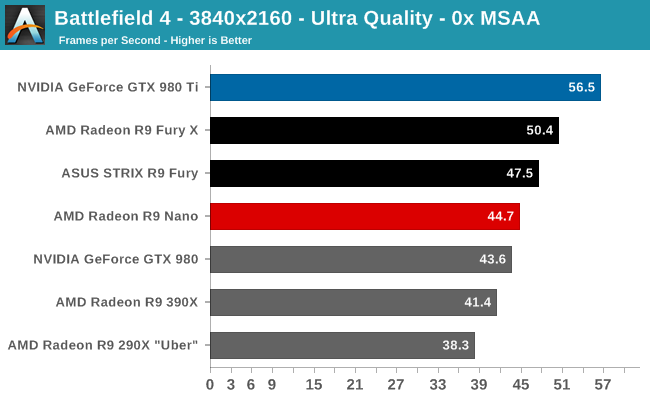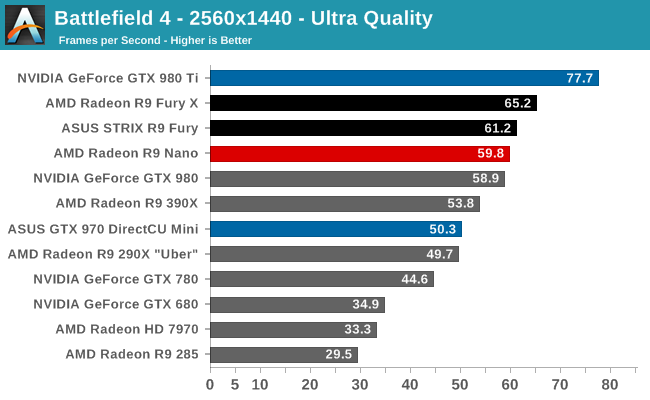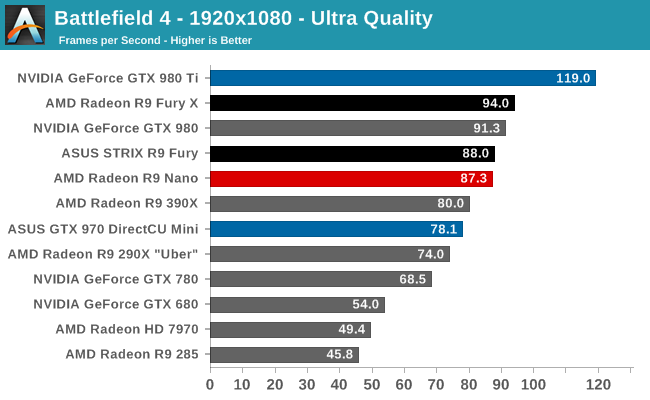The AMD Radeon R9 Nano Review: The Power of Size
by Ryan Smith on September 10, 2015 8:00 AM ESTBattlefield 4
Kicking off our benchmark suite is Battlefield 4, DICE’s 2013 multiplayer military shooter. After a rocky start, Battlefield 4 has since become a challenging game in its own right and a showcase title for low-level graphics APIs. As these benchmarks are from single player mode, based on our experiences our rule of thumb here is that multiplayer framerates will dip to half our single player framerates, which means a card needs to be able to average at least 60fps if it’s to be able to hold up in multiplayer.




Like the other Fiji cards, AMD is promoting the R9 Nano in part on its 4K capabilities. And while we disagree that this card is suitable for 4K gaming based on its sub-Fury performance, we’re including 4K results anyhow to serve as a point of comparison.
In any case Battlefield 4 is often a good indicator of general card performance, and for the R9 Nano this is no exception. What we find is that the R9 Nano trails the other Fury cards in all cases. However to our initial surprise, the R9 Nano sticks rather close to the R9 Fury. The petite powerhouse trails the R9 Fury by only 1-6%, which for the record is a smaller gap than we were expecting.
While the R9 Nano packs a full Fiji GPU, AMD has to pull back on clockspeeds to hit their power targets; in the case of Battlefield 4 this is an average clockspeed of just 879MHz at 2560x1440. Given this we had been expecting the R9 Nano to deliver around 85-90% of the performance of the R9 Fury (and about 80% of the R9 Fury X), based on the assumption that average clockspeeds would be closer to 800MHz. So the fact that the R9 Nano starts off as close to the R9 Fury as it does – even if it’s still trailing it – is a pleasant surprise.
Otherwise with performance still clearly occupying a position as a “3rd tier” Fiji card, I’m not sure if anything about these results should be surprising. On a price/performance basis AMD is not intending to be competitive with other $650 cards, so the R9 Fury X and GTX 980 Ti are of course on the top of the heap. What you get instead is a card that delivers around 90% of R9 Fury X’s performance in BF4 with much less power consumption.
Moving on, compared to the lower power and smaller cards, the R9 Nano is as expected a clean sweep. Demonstrating the virtues of a wide and lower clocked processor’s ability to deliver strong performance without requiring extreme power, everything from the R9 285 to the GTX 980 trails the R9 Nano here. Compared to the GTX 970 Mini in particular, the R9 Nano is 12-26% faster depending on the resolution.
The one potential problem here for the R9 Nano is the GTX 980. Though not a Mini-ITX card, the GTX 980’s power consumption is going to be fairly close to the R9 Nano’s, definitely more so than GTX 970’s. From a power efficiency standpoint it’s the GTX 980 that poses the greatest challenge to the R9 Nano, and while it’s ahead of the GTX 980 in this case at 2560x1440 and higher, it’s a sign that AMD should be worried about what could happen if an NVIDIA partner produced a Mini-ITX GTX 980.










284 Comments
View All Comments
SeanJ76 - Thursday, September 10, 2015 - link
AMD is about to claim bankruptcy......silverblue - Friday, September 11, 2015 - link
Somebody just bought 20% of their shares. If you want them to file chapter 11, be a little more patient, grasshopper.close - Thursday, September 10, 2015 - link
Guess Nvidia is dead to you as a brand also for the whole 3.5GB issue (which we all know how well was handled). That leaves you with the Intel iGPU. But some people have the little fetish of being crapped on from a single direction.Saying "they're dead to me as a brand" is the same as saying "from now on I will disconsider their offerings even if they may be better value or simply better". And this does you no favors, trust me.
Azix - Thursday, September 10, 2015 - link
Does AMD not give out review guidelines? It seems that's something nvidia does. eg when the Ashes benchmark came out they told review sites not to use AA, a lot didn't. Maybe AMD figures some sites will ignore this guidance. eg. if they said nano was not to be compared to the 980ti or fury X and was a niche product for small cases, some sites like kitguru would still compare it to a 980ti rather than the closest mini GPUgw74 - Thursday, September 10, 2015 - link
It is none of the companies' business how their products are reviewed. Their only business to make good products. Anyone can compare anything they like to anything else and benchmark it using anything they want.ianmills - Thursday, September 10, 2015 - link
I wish it was but even anandtech falls in line with this and overuses company's marketing terms to make it hard to compare to previous generationsRyan Smith - Thursday, September 10, 2015 - link
Interesting. I'm certainly not trying to "fall in line" or otherwise use specific marketing terms, so if I'm doing that then it's unplanned. What terms have I been using, so that I can watch out for it in the future?Alexvrb - Friday, September 11, 2015 - link
Yeah! Tell em gw! Same with automotive testing. No guidelines, no rules! If they loan you a 1-ton pickup truck and you compare it to sports cars on a twisty track, bash the truck and give it a horrible review for "poor handling vs 500K exotic sports cars" - well that's none of their business!/sarcasm
gw74 - Sunday, September 13, 2015 - link
I am talking about no guidelines or rules from the manufacturers, genius. That obviously does not mean the reviewing party does not use its brain to compare and test in a sensible way. You absolute clown.Kutark - Thursday, September 10, 2015 - link
They're not demands, they're just telling people ahead of time if there is a particular game that is exhibiting issues with a particular setting. Which especially if its an in progress issue they're debugging, doesn't paint a good picture of the product, and only serves to give ammunition for detractors to cherry pick data points to use in their crusades.